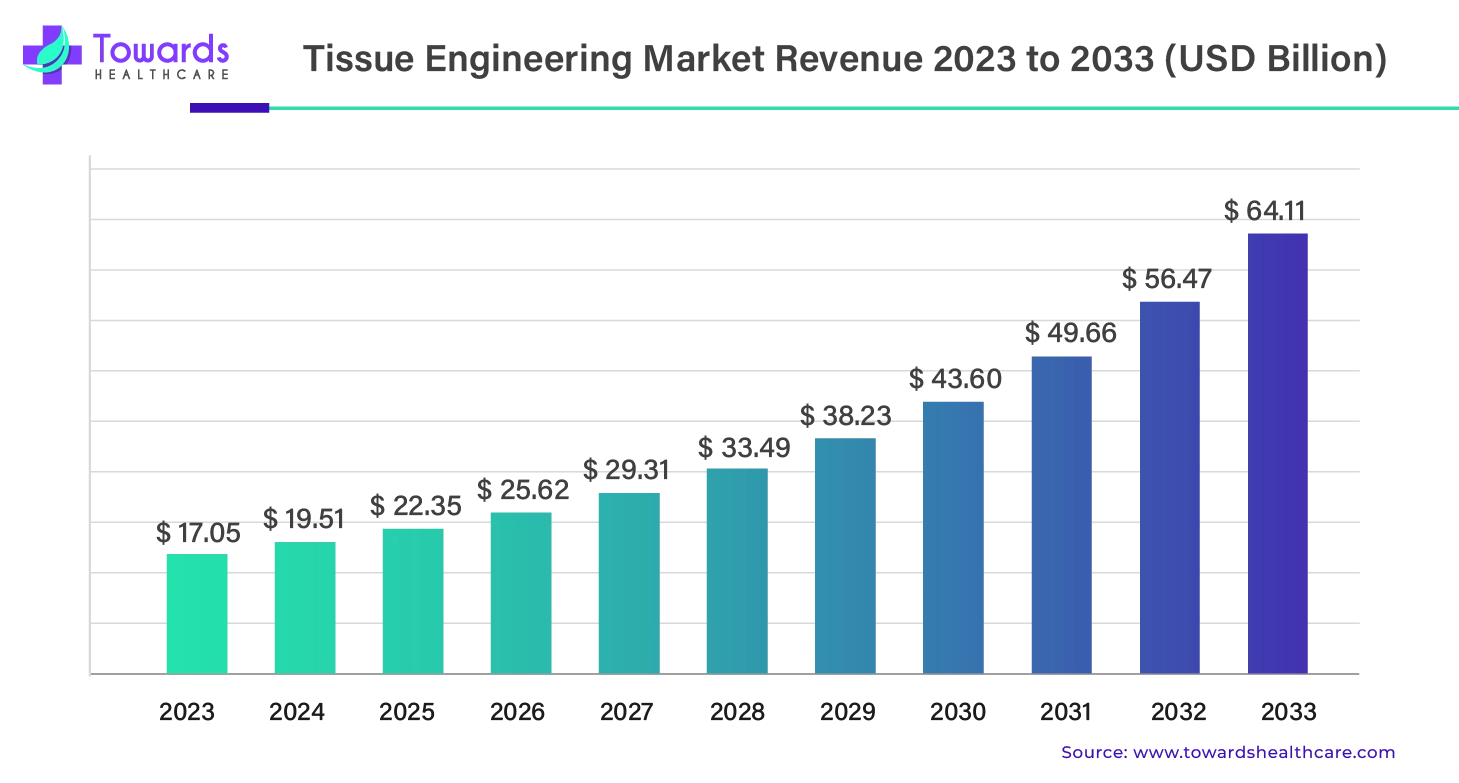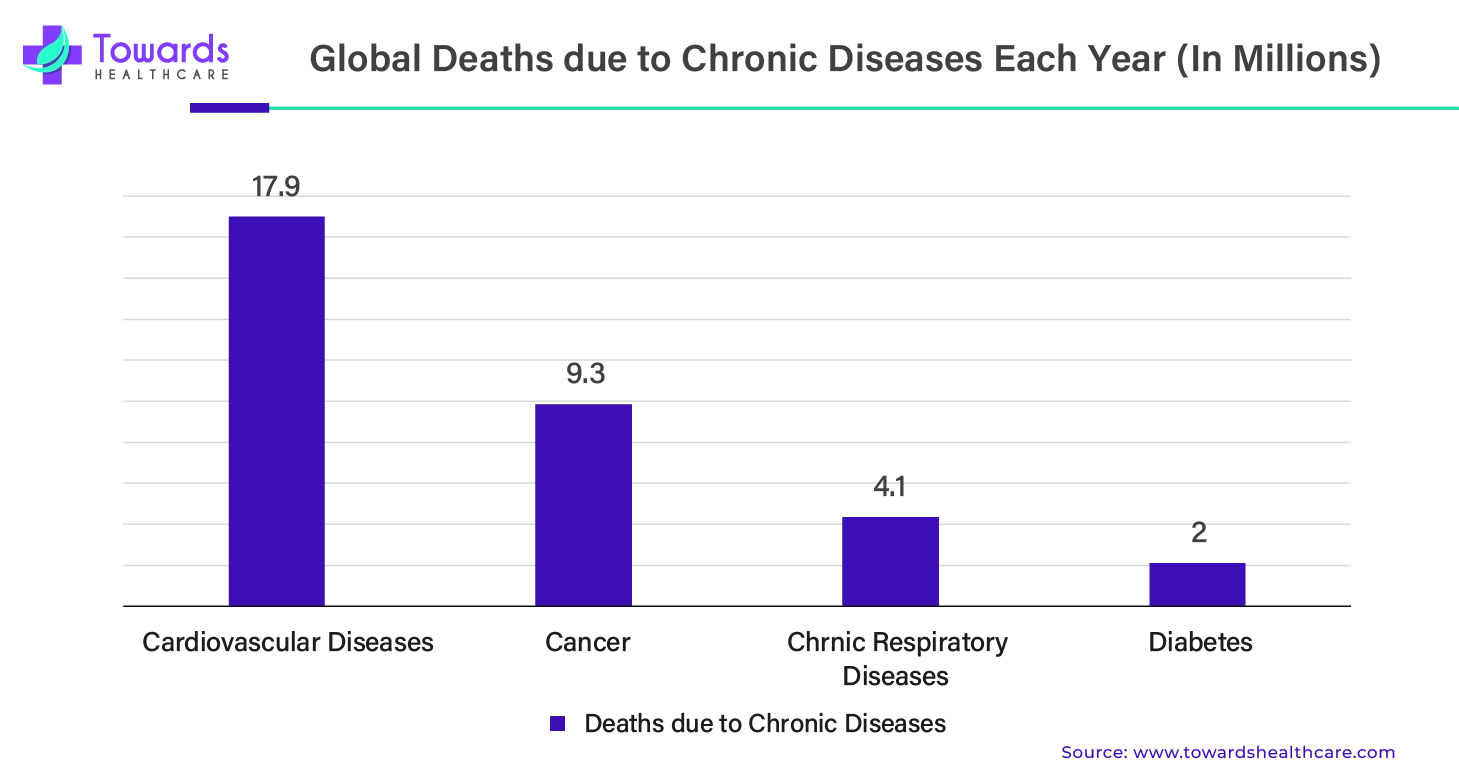December 2024


Principal Consultant

Reviewed By
The global tissue engineering market size was estimated at US$ 17.05 billion in 2023 and is projected to grow to US$ 64.11 billion by 2033, rising at a compound annual growth rate (CAGR) of 14.35% from 2024 to 2033. The need for tissue engineering solutions that can replace or repair damaged tissues has been fueled by the rising prevalence of chronic illnesses, including diabetes, cardiovascular disease, and orthopedic problems.

The field of biomaterials development gave rise to the tissue engineering market, which now includes the process of creating functional tissues using scaffolds, cells, and biologically active chemicals. Creating functional constructions that preserve, repair, or enhance damaged tissues or whole organs is the aim of tissue engineering. The challenges surrounding donor organs and tissues, as well as the shortcomings of the available treatments for clinical tissue damage, may be resolved by tissue engineering. The reconstruction of tissues (such as tendons, vascular, nerve, bone, and cartilage) and other organs (such as the kidney, pancreas, and liver) is only one example of the variety of options available for producing replacement body parts.
| Company Name | TissueLabs |
| Headquarters | Manno, Switzerland, Europe |
| Recent Development | In March 2024, with its headquarters located in Manno, in the canton of Ticino, TissueLabs is a firm that specializes in producing synthetic organs and tissues for medicinal uses. The company recently raised $800,000 in pre-seed funding. In a news statement, it was said that the Brazilian venture capital company Mergus Ventures led the fundraising round, with participation from individual investors, MIT Angels, and other funds. A portion of the funds has been set aside expressly for Bellinzona's new hub. |
| Company Name | Bioserve |
| Headquarters | Yokohama, Japan, Asia Pacific |
| Recent Development | In July 2024, the innovative stem cell products that Bioserve India is proud to introduce to the Indian market are now available. These new offerings from REPROCELL are intended to foster scientific innovation and medication development, as well as improvements in the Indian market for regenerative medicine and therapeutic discoveries. The stem cell market is a fast-expanding sector of the economy that offers a vast array of goods and services. Many businesses within the stem cell market are involved in vital tasks, including production, distribution, and research & development related to stem cell treatment. |
Another important component of regenerative medicine that is revolutionizing the treatment of chronic illnesses is tissue engineering. It includes growing synthetic organs and tissues in the lab for use in transplants or fixing the body's damaged tissues. The treatment of diabetes has benefited greatly from one of tissue engineering's biggest advances.
Chronic illnesses, such as diabetes, heart disease, stroke, and cancer, continue to be among the world's top causes of morbidity and mortality. Chronic illness is expected to cost the world economy $47 trillion by 2030. With an estimated annual cost to the nation of $1 trillion, chronic illness places a significant financial strain on the American healthcare system. The World Health Organization (WHO) estimates that noncommunicable diseases (NCDs) cause 41 million deaths globally each year, or 74% of all deaths. 17 million people die from NCDs before they become 70 years old each year; 86% of these premature deaths occur in low- and middle-income countries.

Forming scaffolds with the appropriate parameters to mimic an appropriate microenvironment for cells is a demanding task since it is hard to manage the internal pore structure, porosity, and pore connectivity of the scaffolds in these ways. For rapid deployment in clinical applications, scaffold manufacturers should prioritize both appropriate biological characteristics and economical scaffold production. In addition, leftover organic solvents from the scaffolds can cause cell harm.
Smart polymers could provide a solution to the issues with the scaffolds now used in tissue engineering. Tissue engineering uses smart polymers that can respond to stimuli, change shape, or heal themselves. With four-dimensional (4D) printing, objects that are three-dimensional (3D) can have their shapes altered in response to temperature, moisture, water, pH, light, and other environmental factors over time. Recently, a lot of attention has also been paid to this technology. It is expected that further study into the synthesis of smart hydrogels with simultaneous shape memory and self-healing properties will be conducted in the subsequent years.
The scaffold segment held the dominant share of the tissue engineering market and is expected to grow at the fastest rate during the forecast period. The structural support for cell adhesion and subsequent tissue formation is provided by scaffolds, which are often composed of polymeric biomaterials. In order to replace or repair damaged or destroyed tissues, tissue-engineering scaffolds composed of different biomaterials have been produced throughout the past ten years.
For instance,
The synthetic segment held the largest share of the tissue engineering market and is expected to hold the dominant position during the forecast period. Polyesters, polyanhydrides, polyphosphazenes, polyurethane, and poly (glycerol sebacate) are examples of synthetic biodegradable polymers that are frequently utilized in tissue engineering. The synthetic biodegradable polymers that are most commonly utilized in tissue regeneration are aliphatic polyesters. Typically, synthetic polymers are immune system-safe, have a more flexible processing degree, and have a regulated structure.
The orthopedics & musculoskeletal segment dominated the tissue engineering market in 2023. Bone diseases, tumor removal, fractures, and infections can all result in bone abnormalities. One promising method for treating clinical needs for bone regeneration and repair is tissue engineering. The construction of 3D scaffolds, which offer structural support for the formation of new bone, is the primary goal of tissue engineering in orthopedics. The therapy of orthopedic pathologies will be on tissue engineering with biomaterials in the future. Due to its special qualities, silk is a promising biopolymer in these applications for hard and soft tissue engineering.
For instance,
The hospitals segment dominated the tissue engineering market in 2023. All hospital medical equipment is managed by the Department of Biomedical Engineering. In order to ensure the safe and efficient use of healthcare technology, the biomedical engineer provides support to the healthcare providers during the technology acquisition process. This support is provided through a well-designed program of user training, maintenance, and quality assurance. To provide the best possible care, hospitals stock their facilities with operational, calibrated, and safe medical equipment. This helps minimize patient discomfort and aggravation from broken equipment and lost time due to equipment malfunction.
North America dominated the tissue engineering market in 2023. A bigger tissue engineering market share is also a result of the region's high healthcare expenditures, easy access to government and private funding, and cutting-edge chronic illness diagnosis and treatment technology. The rise in popularity of stem cell therapy, the aging population, the availability of both government and private funding, improved chronic illness diagnosis and treatment technology, and high healthcare costs are all contributing factors to the growth. The region's dominant position in the market is a result of several forces working together.
In the North American region, the U.S. has the most tissue engineering market share. With the assistance of important market participants and government support, the U.S. contributes to the expansion. A call for proposals that use the International Space Station (ISS) National Laboratory to further tissue engineering and mechanobiology research is being funded by the U.S. National Science Foundation (NSF). NSF will finance up to $1.6 million through this proposal for a number of projects that aim to make use of the orbiting laboratory.
The National Science Foundation (NSF) advances fundamental research in all branches of science and engineering, therefore driving national progress. In order to maintain American leadership in research and innovation around the world and to promote the creativity of researchers, NSF provides facilities, tools, and funds. NSF funding, which has a $9.5 billion budget for the fiscal year 2023, is distributed to almost 2,000 schools, universities, and other institutions in all 50 states. Over 40,000 competitive proposals are received by NSF annually, and approximately 11,000 new awards are made.
Asia Pacific is expected to grow at the fastest rate during the forecast period. Japan has become a pioneer in tissue engineering technology development. The market for tissue engineering is also expanding due to the rising incidence of clinical illnesses, such as cancer, in Asia. Tissue engineering market growth is also fueled by factors like the development of 3D bioprinting technology and the expansion of medical tourism in the area.
Together, the government and business community in Japan are implementing ambitious regulatory reform and actively encouraging international firms to invest in order to further this field. With over JPY 1 billion (USD 9 million) in financial support available, the Japan External Trade Organization (JETRO) has taken the lead in efforts to assist foreign businesses that invest in regenerative medicine in Japan.
By Product
By Material
By Application
By End User
By Region
The cell separation is expanding rapidly due to its diverse applications across several fields, including therapeutics, diagnostics and personalized medicine by isolating specific cells from mixed samples. Cell separation, also known as cell isolation or sorting, involves extracting specific cell populations from a mixture of different cells. This process allows scientists to focus on isolated cells by minimizing the influence of other cell types, which is crucial for accurate research and analysis.
Isolated cells play a significant role in life science research, enabling scientists to conduct precise tests and develop targeted treatments. One of the key factors driving the growth of the cell separation market is the increasing demand for personalized medicine. This technology also contributes to creating effective and scalable treatment methods for large populations.
December 2024
December 2024
December 2024
December 2024